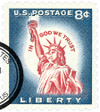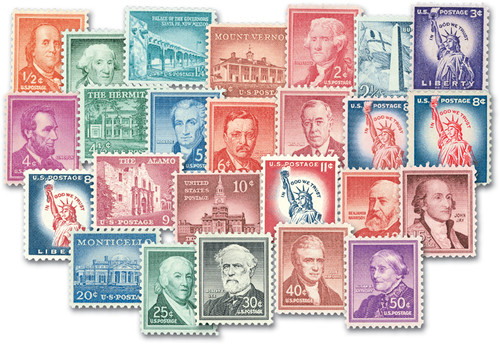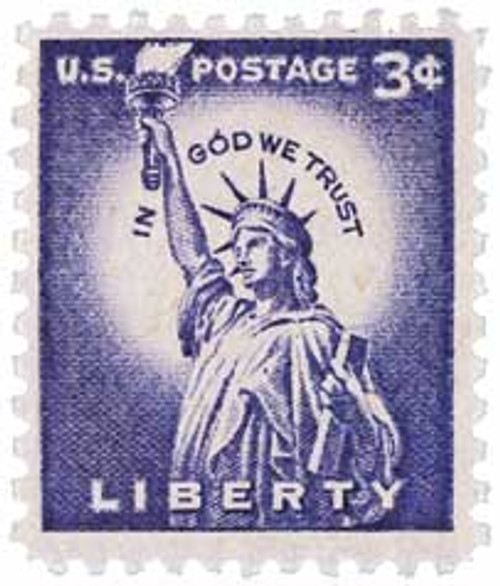
1958 Liberty Series,8¢ Statue of Liberty, Redrawn, Giori Press
# 1042 - 1958 Liberty Series - 8¢ Statue of Liberty, Redrawn, Giori Press
$0.35 - $55.00
U.S. #1042
8¢ Statue of Liberty
Liberty Series
8¢ Statue of Liberty
Liberty Series
Issue Date: March 22, 1958
City: Cleveland, Ohio
Printed by: Bureau of Engraving and Printing
Printing Method: Giori Press
Perforations: 11
Color: Dark violet blue and carmine rose
City: Cleveland, Ohio
Printed by: Bureau of Engraving and Printing
Printing Method: Giori Press
Perforations: 11
Color: Dark violet blue and carmine rose
U.S. #1042 features redrawn version of the Statue of Liberty as it appeared on U.S. #1041 and #1041B. While the previous issues, printed on the Flat Plate and Rotary Presses, had to be run through the printer twice, #1042 was printed on Giori press, which could print both colors on a single pass through the press.
Liberty Enlightening the World
The Statue of Liberty is a magnificent copper sculpture given to the United States by France in 1884. On October 28, 1886, the statue was dedicated. Its complete name is Liberty Enlightening the World. This majestic symbol of the United States, representing freedom for immigrants coming to America as well as the bond of freedom shared between the United States and France, stands above Liberty Island at the entrance to New York Harbor in Upper New York Bay.
The people of France donated the money to build the statue, and the people of America raised the funds to build its base. The French sculptor Frédéric Auguste Bartholdi designed the statue and chose its location. Alexandre Gustave Eiffel, the French engineer who later built the Eiffel Tower in Paris, designed the statue’s framework. The statue stands 301 feet and 1 inch high from foundation to torch.
In the early 1980s, a program was started to make major repairs and improvements to the statue. This effort concluded in 1986 – the 100th anniversary of the Statue of Liberty’s dedication in the U.S. A popular tourist attraction, the statue attracts about 2 million visitors each year.
The Liberty Series
Issued to replace the 1938 Presidential series, this patriotic set of stamps honors guardians of freedom throughout U.S. history. Eighteenth century America is represented by Revolutionary War heroes and statesmen such as Washington, Jefferson, Franklin, Hamilton, Henry, Jay, and Revere.
Leaders of the 19th century including Monroe, Lincoln, Lee, Harrison, and Susan B. Anthony make an appearance. The 20th century is represented by Teddy Roosevelt, Woodrow Wilson, and General Pershing.
The Liberty Series also features famous locations important to America’s democratic history, such as Bunker Hill, Independence Hall, and the Alamo.
“Wet” versus “Dry” Printing
The Bureau of Engraving and Printing began an experiment in 1954. In previous “wet” printings, the paper had a moisture content of 15 to 35 percent. In the experimental “dry” printings, the paper had a moisture content of 5 to 10 percent. This process required stiffer, thicker paper, special inks, and greater pressure to force the paper through the plates.
Stamps produced by dry printing can be distinguished by whiter paper and higher surface sheen. The stamps feel thicker and the designs are more pronounced than on wet printings. So the dry printing experiment was a success, and all U.S. postage stamps have been printed by this method since the late 1950s.
U.S. #1042
8¢ Statue of Liberty
Liberty Series
8¢ Statue of Liberty
Liberty Series
Issue Date: March 22, 1958
City: Cleveland, Ohio
Printed by: Bureau of Engraving and Printing
Printing Method: Giori Press
Perforations: 11
Color: Dark violet blue and carmine rose
City: Cleveland, Ohio
Printed by: Bureau of Engraving and Printing
Printing Method: Giori Press
Perforations: 11
Color: Dark violet blue and carmine rose
U.S. #1042 features redrawn version of the Statue of Liberty as it appeared on U.S. #1041 and #1041B. While the previous issues, printed on the Flat Plate and Rotary Presses, had to be run through the printer twice, #1042 was printed on Giori press, which could print both colors on a single pass through the press.
Liberty Enlightening the World
The Statue of Liberty is a magnificent copper sculpture given to the United States by France in 1884. On October 28, 1886, the statue was dedicated. Its complete name is Liberty Enlightening the World. This majestic symbol of the United States, representing freedom for immigrants coming to America as well as the bond of freedom shared between the United States and France, stands above Liberty Island at the entrance to New York Harbor in Upper New York Bay.
The people of France donated the money to build the statue, and the people of America raised the funds to build its base. The French sculptor Frédéric Auguste Bartholdi designed the statue and chose its location. Alexandre Gustave Eiffel, the French engineer who later built the Eiffel Tower in Paris, designed the statue’s framework. The statue stands 301 feet and 1 inch high from foundation to torch.
In the early 1980s, a program was started to make major repairs and improvements to the statue. This effort concluded in 1986 – the 100th anniversary of the Statue of Liberty’s dedication in the U.S. A popular tourist attraction, the statue attracts about 2 million visitors each year.
The Liberty Series
Issued to replace the 1938 Presidential series, this patriotic set of stamps honors guardians of freedom throughout U.S. history. Eighteenth century America is represented by Revolutionary War heroes and statesmen such as Washington, Jefferson, Franklin, Hamilton, Henry, Jay, and Revere.
Leaders of the 19th century including Monroe, Lincoln, Lee, Harrison, and Susan B. Anthony make an appearance. The 20th century is represented by Teddy Roosevelt, Woodrow Wilson, and General Pershing.
The Liberty Series also features famous locations important to America’s democratic history, such as Bunker Hill, Independence Hall, and the Alamo.
“Wet” versus “Dry” Printing
The Bureau of Engraving and Printing began an experiment in 1954. In previous “wet” printings, the paper had a moisture content of 15 to 35 percent. In the experimental “dry” printings, the paper had a moisture content of 5 to 10 percent. This process required stiffer, thicker paper, special inks, and greater pressure to force the paper through the plates.
Stamps produced by dry printing can be distinguished by whiter paper and higher surface sheen. The stamps feel thicker and the designs are more pronounced than on wet printings. So the dry printing experiment was a success, and all U.S. postage stamps have been printed by this method since the late 1950s.



















